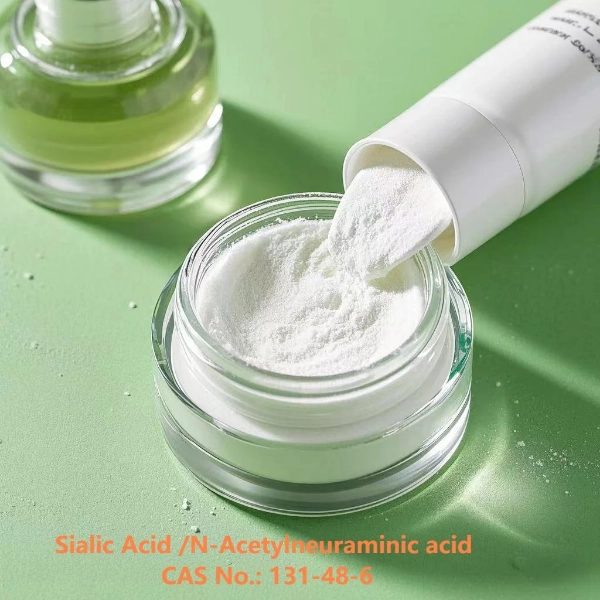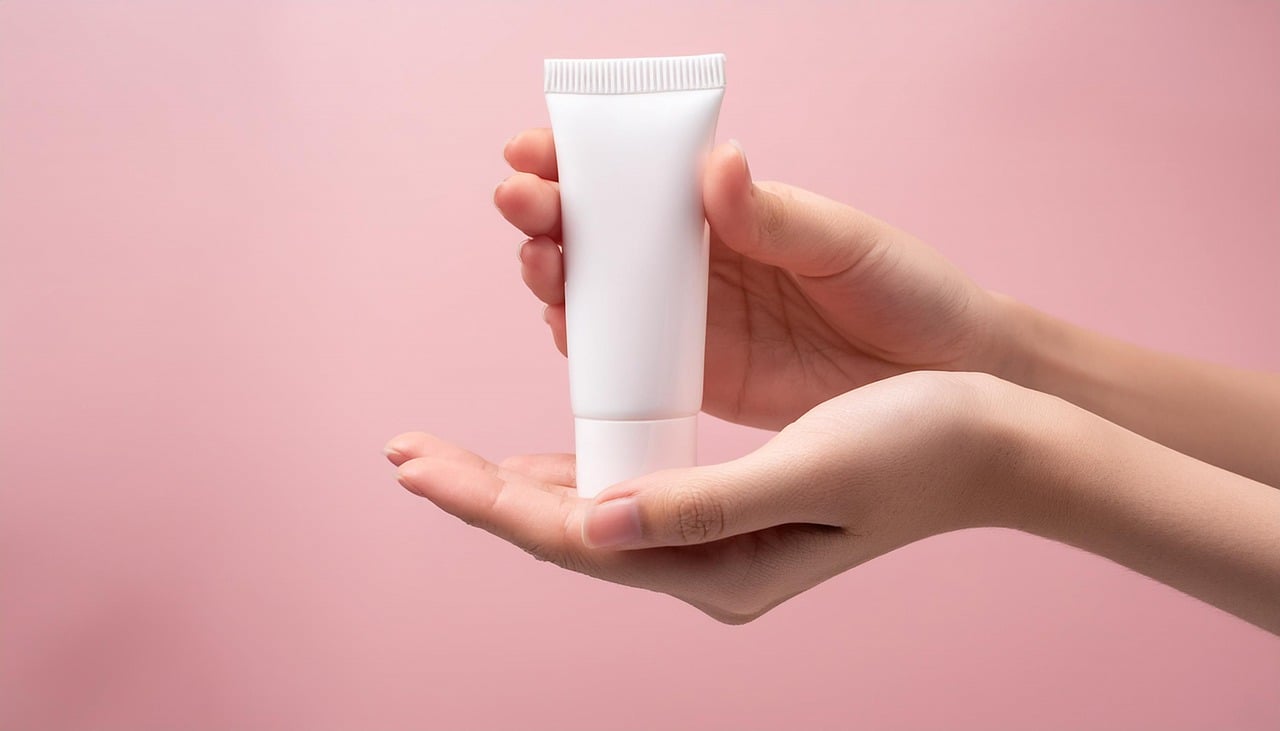- This topic is empty.
-
AuthorPosts
-
2025-07-23 at 3:42 pm #10181
N-Acetylneuraminic Acid (CAS No.:131-48-6), commonly referred to as Sialic Acid, is a nine-carbon acidic monosaccharide found at the terminal position of glycan chains on glycoproteins and glycolipids. In this blog post, SACH, a high purity natural cosmetic raw materials manufacturer, will share the skin repair effects of N-Acetylneuraminic Acid Sialic Acid, including biochemical properties, skin repair mechanisms, etc.
1. Biochemical Properties of Sialic Acid in Skin Physiology
Sialic Acid (CAS No.:131-48-6) is a key component of the glycocalyx – the carbohydrate-rich layer that covers the exterior of skin cells, particularly keratinocytes in the epidermis. Its negative charge contributes to cell repulsion, moisture retention, and barrier function. Biochemically, Sialic Acid influences various cellular functions, including cell signaling, adhesion, and immune response.
In skin, sialylated glycoproteins and glycolipids are particularly important for:
* Maintaining skin hydration through osmotic regulation.
* Modulating inflammatory responses, thanks to their interactions with selectins and siglecs (Sialic Acid-binding immunoglobulin-like lectins).
* Reinforcing the stratum corneum barrier by stabilizing cell-cell junctions.
The decline in natural sialylation with age or due to environmental damage (e.g., UV exposure, pollution) has been linked with impaired skin integrity, reduced repair capacity, and signs of aging.

2. Mechanisms of Skin Repair Mediated by Sialic Acid
The skin repairing effects of Sialic Acid (CAS No.:131-48-6) are multifaceted and involve several key physiological processes:
2.1. Enhancement of Barrier Function
The skin' s outermost layer relies heavily on intercellular lipid and protein complexes. Sialic Acid contributes to the glycosylation of proteins such as transmembrane mucins and integrins, which are essential for barrier function. Enhanced sialylation improves the hydration and cohesion of the epidermis by:
* Reducing transepidermal water loss (TEWL).
* Increasing epidermal thickness.
* Promoting keratinocyte cohesion through sialylated desmosomes.
Clinical formulations enriched with Sialic Acid have demonstrated significant reductions in TEWL, indicating a reinforced skin barrier, especially in individuals with xerosis or atopic dermatitis.
2.2. Modulation of Inflammatory Responses
Inflammation is a double-edged sword in skin repair. While necessary for the initial wound healing cascade, prolonged or excessive inflammation can cause tissue damage. Sialic Acid exhibits immunomodulatory effects by engaging with siglecs on immune cells, particularly macrophages and neutrophils. This interaction:
* Dampens overactive inflammatory responses.
* Reduces pro-inflammatory cytokines such as IL-6 and TNF-α.
* Promotes the resolution phase of inflammation, aiding in faster wound closure.
These properties make Sialic Acid a promising candidate for treating inflammatory skin conditions like eczema, rosacea, and contact dermatitis.
2.3. Promotion of Cell Proliferation and Migration
Efficient skin repair requires rapid proliferation and migration of keratinocytes and fibroblasts. Sialic Acid-modified glycoproteins (e.g., epidermal growth factor receptor, EGFR) have higher stability and activity, enhancing downstream signaling pathways such as MAPK/ERK, which are vital for cell proliferation.
In vitro studies using human keratinocyte cultures have shown that supplementation with Sialic Acid enhances migration and proliferation rates by up to 30%, indicating accelerated re-epithelialization. Similarly, fibroblast activity in the dermal matrix is enhanced, contributing to extracellular matrix (ECM) remodeling and wound contraction.
3. Antioxidant and Anti-aging Properties of N-Acetylneuraminic Acid Sialic Acid
Aging skin is characterized by the accumulation of reactive oxygen species (ROS), leading to oxidative stress and dermal matrix degradation. Sialic Acid (CAS No.:131-48-6) exhibits notable antioxidant properties through the following mechanisms:
* Direct ROS scavenging, particularly of hydroxyl radicals and peroxynitrite.
* Upregulation of endogenous antioxidant enzymes, including superoxide dismutase (SOD) and glutathione peroxidase (GPx).
* Inhibition of matrix metalloproteinases (MMPs) that degrade collagen and elastin.
In vivo application of Sialic Acid-containing creams has been associated with visible reductions in fine lines and improved dermal density over 6–8 weeks, likely due to its antioxidant support and collagen preservation.

4. Hydration and Moisture Retention of N-Acetylneuraminic Acid Sialic Acid
Skin hydration is fundamental to repair, resilience, and aesthetics. Sialic Acid plays a vital role in hydration through:
* Hygroscopicity: Its polar, acidic nature attracts and retains water molecules.
* Glycoprotein stabilization: It supports the integrity of natural moisturizing factors (NMFs).
* Stimulation of hyaluronic acid synthesis: Sialic Acid has been linked with enhanced expression of hyaluronan synthase enzymes, contributing to increased dermal water content.
Compared to traditional humectants like glycerin or urea, Sialic Acid offers a biomimetic approach that aligns with the skin' s native glycan structures, resulting in deeper and longer-lasting hydration.
5. Wound Healing and Tissue Regeneration
Skin injury activates a complex cascade of events involving coagulation, inflammation, proliferation, and remodeling. Sialic Acid supports wound healing in several stages:
* Hemostasis and Inflammation: Modulation of platelet and leukocyte adhesion prevents excessive coagulation and inflammatory infiltration.
* Proliferation: Accelerates the growth and migration of epithelial cells, fibroblasts, and endothelial cells.
* Matrix remodeling: Promotes synthesis of collagen types I and III while regulating MMP activity for balanced ECM turnover.
Animal models of full-thickness skin wounds treated with topical Sialic Acid showed 40–50% faster closure rates compared to untreated controls, along with reduced scarring and normalized collagen fiber alignment.
6. Synergy with Other Dermatological Agents
Sialic Acid functions synergistically with other active ingredients to enhance skin repair. Notable combinations include:
* Niacinamide: Jointly improves barrier function and reduces hyperpigmentation.
* Ceramides: Complements lipid barrier repair for chronic dry skin.
* Peptides: Enhances signaling pathways involved in dermal regeneration.
In formulations, Sialic Acid' s stability and bioavailability are critical. Encapsulation technologies such as liposomes and nanospheres have improved its dermal penetration and sustained release, maximizing its efficacy.
7. Clinical and Cosmetic Applications of N-Acetylneuraminic Acid Sialic Acid
Given its diverse skin-beneficial effects, Sialic Acid is being explored in multiple clinical and cosmeceutical settings:
* Post-procedure recovery: For use after laser treatments, microneedling, or chemical peels.
* Chronic wound care: Adjunctive treatment for diabetic ulcers and pressure sores.
* Anti-aging skincare: Incorporated into serums, creams, and masks targeting wrinkles, elasticity loss, and dullness.
* Barrier repair creams: Especially in conditions like atopic dermatitis or psoriasis.
Emerging evidence from randomized controlled trials suggests that Sialic Acid-containing creams significantly outperform placebos in terms of barrier restoration, erythema reduction, and patient-reported comfort scores.
8. Safety and Biocompatibility
Sialic Acid is naturally present in the human body, especially in mucosal tissues, making it highly biocompatible and well-tolerated. It shows low cytotoxicity even at higher concentrations and does not typically induce allergic or sensitization responses.
Formulation considerations include:
* pH sensitivity: Optimal efficacy is maintained in mildly acidic formulations (pH 4.5–6).
* Stability: Should be stored in opaque, airtight packaging to avoid degradation.
* Compatibility: Well-tolerated alongside most active ingredients, though formulation testing is advised.
Conclusion
The skin repairing effects of N-Acetylneuraminic Acid (Sialic Acid) are rooted in its complex biological interactions within the epidermal and dermal environment. From enhancing barrier function and hydration to modulating inflammation and promoting cellular regeneration, Sialic Acid stands out as a potent bioactive agent for advanced skincare and wound healing applications.
-
AuthorPosts
- You must be logged in to reply to this topic.